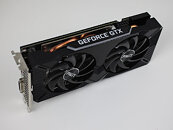- Joined
- Oct 9, 2007
- Messages
- 47,649 (7.44/day)
- Location
- Dublin, Ireland
| System Name | RBMK-1000 |
|---|---|
| Processor | AMD Ryzen 7 5700G |
| Motherboard | Gigabyte B550 AORUS Elite V2 |
| Cooling | DeepCool Gammax L240 V2 |
| Memory | 2x 16GB DDR4-3200 |
| Video Card(s) | Galax RTX 4070 Ti EX |
| Storage | Samsung 990 1TB |
| Display(s) | BenQ 1440p 60 Hz 27-inch |
| Case | Corsair Carbide 100R |
| Audio Device(s) | ASUS SupremeFX S1220A |
| Power Supply | Cooler Master MWE Gold 650W |
| Mouse | ASUS ROG Strix Impact |
| Keyboard | Gamdias Hermes E2 |
| Software | Windows 11 Pro |
NVIDIA has finally laid to rest the last GeForce GPUs to feature the "GTX" brand extension, the GTX 16-series "Turing." Although two generations older than the current RTX 40-series "Ada," the GTX 16-series formed the entry-level for NVIDIA, with certain SKUs continuing to ship to graphics card manufacturers, and more importantly, notebook ODMs as popular GeForce MX and GTX 16-series SKUs. With NVIDIA introducing further cut-down variants of its "Ampere" based GA107 silicon, such as the desktop RTX 3050 6 GB, the company has reportedly discontinued the GTX 16-series. All its inventories are drained on NVIDIA's end, and the channel is expected to consume the last remaining chips in the next 1-3 months, according to a source on Chinese forum Broad Channels.
NVIDIA had originally conceived the GTX 16-series to form the lower half of its 2018 product stack, with the upper half driven by the RTX 20-series. Both are based on the "Turing" graphics architecture, but the GTX 16-series has a reduced feature-set, namely the lack of RT cores and Tensor cores. The idea at the time behind the GTX 16-series, was that at their performance levels, ray tracing would be prohibitively slow at any resolution, and so these could be left with just the CUDA cores of "Turing," and made to power games with pure raster 3D graphics, so gamers could at least benefit from the higher IPC and 12 nm efficiency of "Turing" over the 16 nm "Pascal." Popular GPU models include the GTX 1650, and the GTX 1660 Super.

View at TechPowerUp Main Site | Source
NVIDIA had originally conceived the GTX 16-series to form the lower half of its 2018 product stack, with the upper half driven by the RTX 20-series. Both are based on the "Turing" graphics architecture, but the GTX 16-series has a reduced feature-set, namely the lack of RT cores and Tensor cores. The idea at the time behind the GTX 16-series, was that at their performance levels, ray tracing would be prohibitively slow at any resolution, and so these could be left with just the CUDA cores of "Turing," and made to power games with pure raster 3D graphics, so gamers could at least benefit from the higher IPC and 12 nm efficiency of "Turing" over the 16 nm "Pascal." Popular GPU models include the GTX 1650, and the GTX 1660 Super.

View at TechPowerUp Main Site | Source






